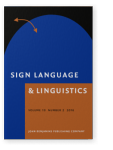Becker, Laura
2024.
Levshina, Natalia. 2022. Communicative Efficiency: Language Structure and Use. Cambridge: Cambridge University Press. xviii + 291 pages. Print ISBN: 9781108840798.
Linguistic Typology 0:0

Bosworth, Rain G., Charles E. Wright & Karen R. Dobkins
2019.
Analysis of the visual spatiotemporal properties of American Sign Language.
Vision Research 164
► pp. 34 ff.

Börstell, Carl
2023.
Lexical comprehension within and across sign languages of Belgium, China and the Netherlands.
Glossa: a journal of general linguistics 8:1

Börstell, Carl
2024.
Better letter: iconicity in the manual alphabets of American Sign Language and Swedish Sign Language.
Language and Cognition ► pp. 1 ff.

Börstell, Carl, Tommi Jantunen, Vadim Kimmelman, Vanja de Lint, Johanna Mesch & Marloes Oomen
2019.
Transitivity prominence within and across modalities.
Open Linguistics 5:1
► pp. 666 ff.

Casas, Bernardino, Antoni Hernández-Fernández, Neus Català, Ramon Ferrer-i-Cancho & Jaume Baixeries
2019.
Polysemy and brevity versus frequency in language.
Computer Speech & Language 58
► pp. 19 ff.

Cooperrider, Kensy, Natasha Abner & Susan Goldin-Meadow
2018.
The Palm-Up Puzzle: Meanings and Origins of a Widespread Form in Gesture and Sign.
Frontiers in Communication 3

Emmorey, Karen, Kurt Winsler, Katherine J. Midgley, Jonathan Grainger & Phillip J. Holcomb
2020.
Neurophysiological Correlates of Frequency, Concreteness, and Iconicity in American Sign Language.
Neurobiology of Language 1:2
► pp. 249 ff.

Fenlon, Jordan, Kensy Cooperrider, Jon Keane, Diane Brentari & Susan Goldin-Meadow
2019.
Comparing sign language and gesture: Insights from pointing.
Glossa: a journal of general linguistics 4:1

Ferrara, Lindsay, Benjamin Anible & Lena Mei Kalvenes Anda
Ferrer-i-Cancho, Ramon, David Lusseau & Brenda McCowan
2022.
Parallels of human language in the behavior of bottlenose dolphins.
Linguistic Frontiers 5:1
► pp. 5 ff.

Flaherty, Molly, Asha Sato & Simon Kirby
2023.
Documenting a Reduction in Signing Space in Nicaraguan Sign Language Using Depth and Motion Capture.
Cognitive Science 47:4

Gappmayr, Paris, Amy M. Lieberman, Jennie Pyers & Naomi K. Caselli
2022.
Do parents modify child-directed signing to emphasize iconicity?.
Frontiers in Psychology 13

Heesen, Raphaela, Catherine Hobaiter, Ramon Ferrer-i-Cancho & Stuart Semple
2019.
Linguistic laws in chimpanzee gestural communication.
Proceedings of the Royal Society B: Biological Sciences 286:1896
► pp. 20182900 ff.

Hou, Lynn
2022.
LOOKing for multi-word expressions in American Sign Language.
Cognitive Linguistics 33:2
► pp. 291 ff.

Hou, Lynn
2022.
A Usage-Based Proposal for Argument Structure of Directional Verbs in American Sign Language.
Frontiers in Psychology 13

Lepic, Ryan
2019.
A usage-based alternative to “lexicalization” in sign language linguistics.
Glossa: a journal of general linguistics 4:1

Lutzenberger, Hannah, Katie Mudd, Rose Stamp & Adam Charles Schembri
2023.
The social structure of signing communities and lexical variation: A cross-linguistic comparison of three unrelated sign languages.
Glossa: a journal of general linguistics 8:1

Makaroğlu, Bahtiyar
2021.
What the frequency list can teach us about Turkish sign language?.
Poznan Studies in Contemporary Linguistics 57:4
► pp. 619 ff.

Makaroğlu, Bahtiyar
2023.
The next station: chunking of değİl ‘not’ collocations in Turkish Sign Language.
Cognitive Linguistics 34:3-4
► pp. 371 ff.

Malaia, Evie A., Joshua D. Borneman, Emre Kurtoglu, Sevgi Z. Gurbuz, Darrin Griffin, Chris Crawford & Ali C. Gurbuz
2023.
Complexity in sign languages.
Linguistics Vanguard 9:s1
► pp. 121 ff.

OCCHINO, CORRINE, BENJAMIN ANIBLE & JILL P. MORFORD
2020.
The role of iconicity, construal, and proficiency in the online processing of handshape.
Language and Cognition 12:1
► pp. 114 ff.

Safryghin, Alexandra, Catharine Cross, Brittany Fallon, Raphaela Heesen, Ramon Ferrer-i-Cancho & Catherine Hobaiter
2022.
Variable expression of linguistic laws in ape gesture: a case study from chimpanzee sexual solicitation.
Royal Society Open Science 9:11

Semple, Stuart, Ramon Ferrer-i-Cancho & Morgan L. Gustison
2022.
Linguistic laws in biology.
Trends in Ecology & Evolution 37:1
► pp. 53 ff.

ÖNAL, Erdem & Bahtiyar MAKAROĞLU
2021.
A Lexicological Approach to Look-up Frequency of Turkish Sign Language Dictionary Users.
Dil Eğitimi ve Araştırmaları Dergisi 7:1
► pp. 193 ff.

Östling, Robert, Carl Börstell & Servane Courtaux
2018.
Visual Iconicity Across Sign Languages: Large-Scale Automated Video Analysis of Iconic Articulators and Locations.
Frontiers in Psychology 9

This list is based on CrossRef data as of 16 june 2024. Please note that it may not be complete. Sources presented here have been supplied by the respective publishers.
Any errors therein should be reported to them.
